Shoei Reinvents the Dual Sport Helmet
The Shoei Hornet X2 is a complete re-think of the modern (and popular) Dual Sport helmet.
Shoei has redesigned every aspect of the helmet and the result is a Hornet X2 that is quite different from the Hornet DS, its predecessor.
The most noticeable difference is in the front profile, which has been flattened to provide better outward visibility for the rider.
This has allowed a face shield redesign with a reduced radius that eliminates the severe curvature and poor optical quality of the typical DS helmet.
The new face shield has outstanding optics and together with the spring-loaded rotating side retainer, provides a much tighter seal against the eye port gasket.
The peak (Shoei calls it a visor) was also completely redesigned for superior aerodynamics.
The peak is now separate from the face shield rotating mechanism, which means that the face shield can be removed and changed without removing the peak — another bonus.
The typically large Dual Sport open chin vent has been eliminated and the chin guard profile has been reduced, which adds to the outstanding outward visibility for the wearer.
In addition to all that (and more), the Hornet X2 is also very quiet and has reduced buffeting compared to other DS helmets.
The only downside to all of this is the weight, which is substantial. But the excellent balance and aerodynamics help hide the grams.
The U.S. version meets the DOT standard and some of the extra weight is the result of the Snell 2015 certification.
The Hornet X2 has a five year warranty and there are now 4 shell sizes to span the head range. The internal shape is consistent with other Shoei helmets.
This is a review of the U.S. DOT/Snell version of the Shoei Hornet X2 (Dual Sport) helmet.
The webBikeWorld review of the JIS version of the Shoei Hornet was published July 2006.
The webBikeWorld review of the Shoei Hornet DS was published July 2013.
We’ve been following the Shoei Hornet — one of the first Dual Sport helmets — since the Japanese version was released in 2006 in Japan.
That helmet was described in the original webBikeWorld Shoei Hornet review, published in July 2006 and I have to say, it’s still one of my favorites.
The dual-sport helmet type is basically defined as a motocross helmet with a face shield.
The evolution of the DS helmet has followed with the still-growing popularity of the Dual Sport or Adventure Touring motorcycle.
The DS helmet segment has exploded in recent months, with the release of the Arai XD4 (review), the Touratech (Nexx) Aventuro (review) and lots more.
We also have a Nexx XD1 in the review process and that will be reviewed as a sort of Part 2 to the review of the Shoei Hornet X2.
 Introducing the Shoei Hornet X2
Introducing the Shoei Hornet X2
It was just two years ago that we reviewed the Shoei Hornet DS (review), the immediate predecessor of the Hornet X2. Believe us when we say that the Hornet X2 is completely new in every way.
The Hornet DS was a bit “long in the tooth” even then, so the X2 is a very welcome update.
There are probably still some Hornet DS examples in the retail pipeline but unless they’re giving it away, take a pass and go for the X2 — it’s that good.
Shoei has completely re-thunk (a new word!) the Dual Sport helmet concept, from soup to nuts. Or chin bar to rear exhaust, if you like.
The Hornet X2 basically trumps everything else in the DS helmet category, with one exception: weight.
The “80/20” Dual Sport Helmet?
The new Hornet X2 is sort of an “80/20” Dual Sport helmet, and that’s a good thing.
Think Suzuki V-Strom 1000 ABS (Blog), which is an 80/20 bike (80% street, 20% off-road). Or thinkMetzeler Tourance Next (review) tires, which are an 80/20 Dual Sport tire (actually, both are more like 90/10’s).
Like those, the Hornet X2 addresses the reality of today’s big Dual Sport bike. That is, most of their miles will be clocked on the street.
Let’s face it: if you’re serious about going off road, a hefty V-Strom, GS, KTM Adventure, Yamaha Ténéré, et al would not and should not be your first choice. All of those are 80/20 bikes at best.
They spend way more time posing on the street than bashing through the woods. Owners will scream and whine, but that’s the way it is, sorry.
The newly redesigned Hornet X2 addresses that reality. It’s more street-oriented than other DS helmets, but it’s just as capable as any of the current crop of DS helmets when you take it off-road. If you need more, get an all-out motocross helmet and a pair of goggles.
The Hornet X2 does the business on your adventure tour or anything short of the Trans-America Trail (Report). You can even pull off the face shield (without removing the peak first) and throw on a pair of goggles.
Why you’d want to do that is a question, but know that you can if you wish…
Where to Buy Shoei Hornet X2 Helmet
Check Reviews & Prices on Amazon Check Reviews & Prices On RevZillaSee More Motorcycle Helmets, Motorcycle Visor, Motorcycle Intercom
Paint, Graphics and Overall Quality
Like the Hornet DS we reviewed in 2013, this Hornet X2 is in basic vanilla all-white. This makes for a more difficult assessment of overall paint quality, but both the white size large and white size XL we have exhibit perfect quality in the paint and fittings.
There are zero problems to report and nothing to nitpick, even for nitpickers like us.
Even the newly redesigned peak (Shoei calls it a “visor”) is perfectly aligned, unlike the twisted peak on the Arai XD4 we reviewed just a few weeks ago.
Shoei helmets cost more but one of the things you’re paying for is quality. As we noted in the Hornet DS review, there hasn’t been a Shoei helmet yet that rated anything less than “Outstanding” in the quality department, and that continues with the Hornet X2.
A couple of things to note: the Hornet X2 has a redesigned front profile to make it “flatter”, or less pointed than other DS helmets. This is in line with the 80/20 philosophy and the benefit of the new profile is that the face shield closes much tighter than any other DS helmet we’ve tried.
The new profile also greatly improves the optical quality of the face shield; it’s now no different from a Shoei street helmet, without the distortion apparent in the more pointed or angular DS helmet designs.
The face shield rotates on a spring-loaded attachment, which serves to pull the face shield tightly against the eye port gasket, providing the water-resistant sealing also problematic on some other DS helmets.
And Shoei also re-thunk the design of the peak (visor) attachment interface. The peak is separate from the face shield, which means that the latter can be removed and replaced (with a bit of difficulty) without having to disassemble the screws holding the peak.
Along with the new peak design, these advancements trump other DS helmets and they’re both welcome and useful.
Note that the U.S. versions of the Hornet X2 are also Snell certified to the latest Snell M2015 standard and, of course, meet the DOT specs. Shoei provides a five-year warranty on the helmet.
[UPDATE: YouTube Video: Shoei Hornet X2 colors.]
Score: We give the Shoei Hornet X2 an “Outstanding” rating for excellent overall quality. See the Summary Table at the bottom of the page for a description of our rating system.
Shoei Hornet X2 Helmet Fit, Internal Shape and Liner
Shoei now has the most consistent internal fit and internal shape or profile of any helmet manufacturer we can think of.
The “Shoei Fit” is real and it means a “Slightly Narrow” internal shape that’s pretty close to today’s “Neutral” shape that fits the vast majority of head shapes.
The Hornet X2 now uses 4 shell sizes to span the head size range; the previous Hornet DS used just two.
But there’s still a significant difference between the size L and XL Hornet X2 helmets. The large size fits about a 59 cm head max, while the XL is more of a 61 cm size. That leaves a pretty big gap for the ± 60 cm crowd.
In fact, the size large Hornet X2 we have is just too tight for my “Round” 60.5 cm head. It feels like it has a significant taper towards the bottom, which make it difficult for me to squeeze on to my head.
The XL fits better and allows me to wear straight-temple sunglasses, but it’s slightly loose and there’s a bit too much extra room along the top. It feels identical to a size XL Arai RX-Q (review)with its “Intermediate Oval” internal shape.
All told, the Hornet X2 is completely consistent with the standard Shoei internal shape. So if you know Shoei helmets, you know the Hornet X2.
The interior of the Hornet X2 uses Shoei’s “3D Max-Dry Interior System II”, which is very comfortable (typical for Shoei) and does seem to have noticeably better moisture control in hot weather.
The liner and cheek pads are removable and replaceable and the cheek pads are optionally available in custom sizes. The helmet also has removable foam ear pads.

More information on helmet fit can be found in the webBikeWorld Motorcycle Helmet FAQ page, along with the chart that lists the helmet weights of webBikeWorld reviewed helmets and also by shape on the webBikeWorld Motorcycle Helmet Shapes page.
Score: I’ll give the Shoei Hornet X2 an “Outstanding” rating for shape, comfort and padding with a very nice removable liner and padding.
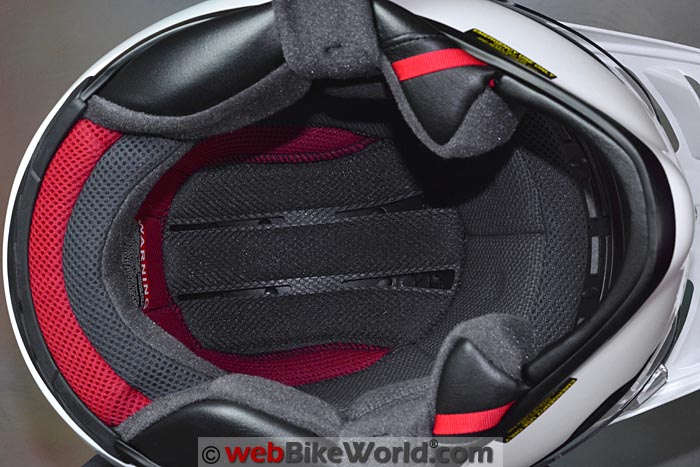
Shoei Hornet X2 Face Shield, Eye Port and Outward Visibility
The most noticeable benefit of the nw flat front profile of the Hornet X2 is apparent the first time you lower the face shield.
Unlike most of the other DS helmets, which keep the pointed front and correspondingly distorted face shield, the Hornet X2’s shield is as optically perfect as any street helmet.
It provides a huge amount of forward visibility with zero distortion and the flatter chin bar also means that there’s better vertical sight lines out the eye port.
Combined with the straighter, more square sides at the eye port, the Hornet X2 really does lead the pack when it comes to visibility. For sure you’ll see other DS helmet manufacturers follow this lead.
Shoei says the new CNS-2 face shield blocks 99% of UV rays.
The face shield also now has a friction snap lock at the bottom, under the lift tab on the left-hand side.
The face shield rotating mechanism is also a new design and it’s tight, making it difficult to lift the shield from the offset tab without bending the face shield across the radius. A centrally located tab would have been a much better idea we think…
The rotating mechanism is spring loaded, so it pulls the face shield tightly against the eye port gasket to keep out dust and water.
The mechanism has 6 detents but unfortunately the first opening position is bigger than we’d like for a city defogging position.
Another part of the new design allows the face shield to be removed without having to first remove the peak. Here’s a quick YouTube video showing the Shoei Hornet X2 face shield removalwith peak in place.
It’s not as easy to do this as it could be because the face shield must be lifted to its topmost position and there’s a little bit of interference with the sides of the peak. But, it can be done with care.
We measured the face shield at 2.24 mm thick and it is also Pinlock-ready and a Pinlock insert comes in the box.

Score: The Shoei Hornet X2 visibility is outstanding and virtually unlimited.
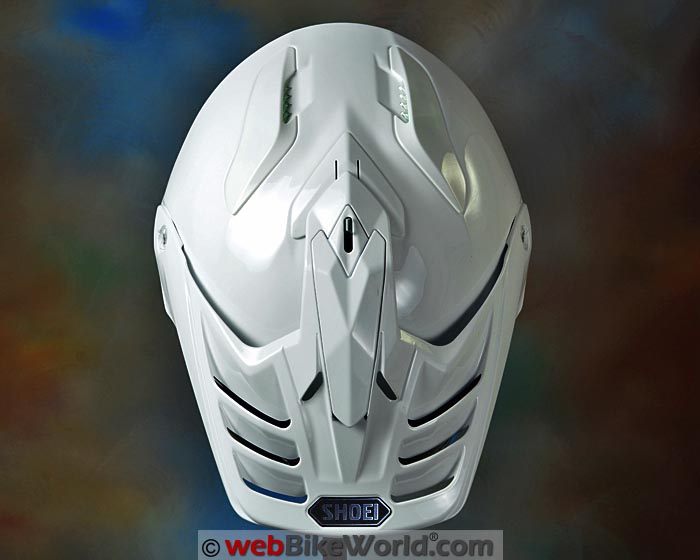
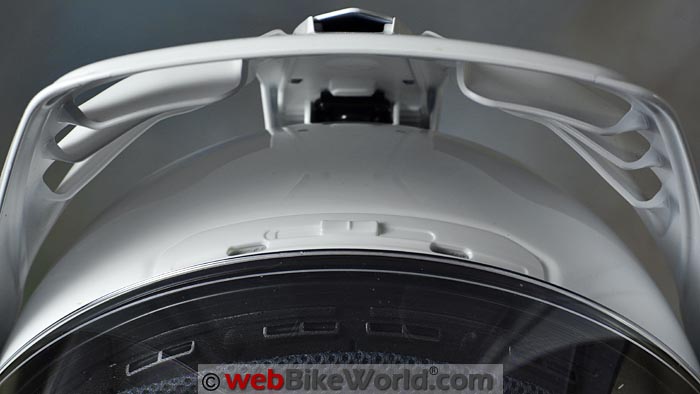
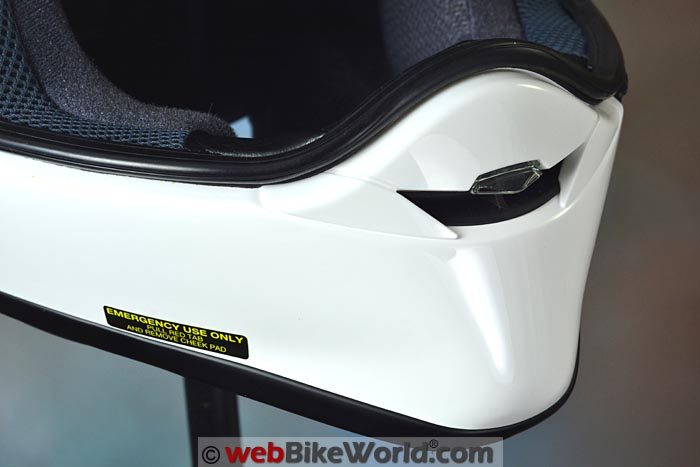
Where to Buy Shoei Hornet X2 Helmet
Check Reviews & Prices on Amazon Check Reviews & Prices On RevZillaSee More Motorcycle Helmets, Motorcycle Visor, Motorcycle Intercom
Shoei Hornet X2 Ventilation
Along with everything else, the ventilation system on the Hornet X2 has been updated.
The chin no longer has the open mesh type off-road helmet opening. Instead, Shoei has given it a street helmet type system.
The chin vent has a very positive on/off rocker tab and the air flows into the helmet through a ~50 mm long slot and on to the rider’s face. Part of the air stream is also directed up along the top of the chin bar.
Although the vent may appear to be smaller than the typical large grid opening of the previous Hornet and other DS helmets, it actually provides more air flow.
The longer “beak” of most DS helmets means the air has more time to dissipate before it hits the rider’s face, especially when the vent opening is farther away from the mouth, as it is on other DS helmets.
A chin curtain is included in the box and the owner can install it in the Hornet X2.
The upper half of the venting system consists of the same brow vents found on the previous version of the Hornet, along with a new system on the top of the helmet.
This is a long removable tube that collects air from the top of the peak and forces it down on to the rider’s head through an opening in the center of the helmet. The vent has another very positive on/off slider switch on top, easy to find and to use when wearing gloves.
The air comes in to the helmet through pairs of holes in the EPS that are unencumbered by liner.
It continues out the rear in a new system of exhaust vents that are located on the inside of a low-pressure channel along the rear part of the top of the helmet.
The system works very nicely and the air flow can be felt all along the top of the helmet — a definite plus.
Overall, the ventilation system in the Hornet X2 is among the best of any helmets — Dual Sport or otherwise — that we have reviewed.

Score: We rate the ventilation system of the Shoei Hornet X2 as “Outstanding” for upper and lower.
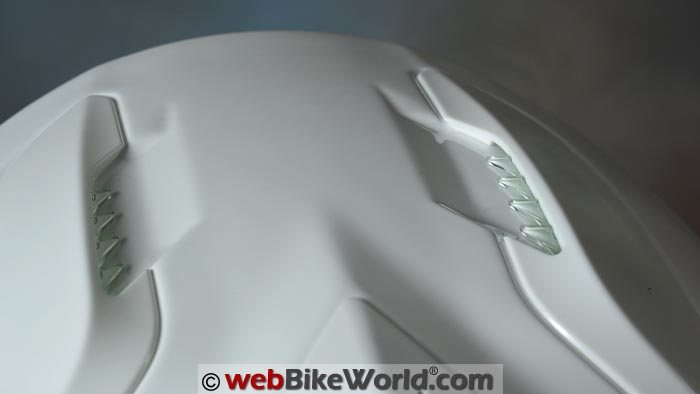
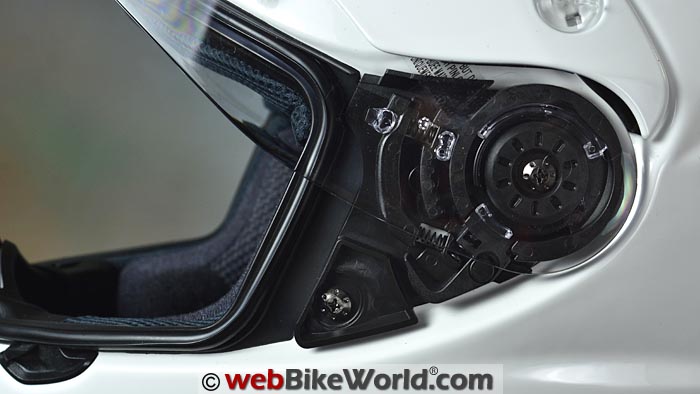
Shoei Hornet X2 Sound Levels
Along with all the other changes to the Hornet X2, the helmet’s noise control properties have been enhanced.
The Hornet X2 is actually very quiet for this type of helmet and it even compares well to the best of the “quiet” full-face street helmets.
As is always the case, when riding behind a shorter type windscreen (typically found on the larger Dual Sport motorcycles), there’s some buffeting along the top where the air hits the peak.
But the new peak design helps; there’s very little lift and less buffeting noise than other DS helmets.
The plush Shoei interior and tapered lower shell helps to reduce noise also and there’s very little additional noise from the top vent when open. The noise levels are perhaps slightly lower than the average street helmet when riding a bike with no windscreen.
Overall, the Shoei Hornet X2 is probably the quietest Dual Sport helmet we have reviewed and a definite improvement over the Shoei Hornet DS, the previous version of this helmet.

Note that our helmet evaluations are a combined effort of several riders over time on different types of motorcycles with and without windscreens.
Evaluators wear correctly fitted, high quality ear plugs (even when evaluating motorcycle intercom systems).
Always protect your hearing when riding a motorcycle. See the wBW Earplug Reviews for more information on choosing and wearing earplugs.
Note also that perceived noise levels will vary, depending on the individual.
Noise can be caused by many factors, including helmet fit, the type of motorcycle and windscreen, wind speed and direction and even the rider’s clothing.
For more information on helmet noise, visit the wBW Motorcycle Helmet Noise page.
Score: The Shoei Hornet X2 rates an “Excellent” for better than average noise control.
Where to Buy Shoei Hornet X2 Helmet
Check Reviews & Prices on Amazon Check Reviews & Prices On RevZillaSee More Motorcycle Helmets, Motorcycle Visor, Motorcycle Intercom
Helmet Weight
The previous version of the Hornet — the Hornet DS — weighed a hefty 1861 grams (4 lbs., 1-5/8 oz.) in size XL.
The Hornet X2 in size XL weighs 1874 grams (4 lbs., 2-1/8 oz.). We also have a Hornet X2 in size L, which weighs 1814 grams (4 lbs. even).
That’s a lot of weight — nearly the limit of any of the nearly 300 motorcycle helmets we have reviewed. Like the Hornet DS, the extra weight of the Hornet X2 could be due to the Snell M2015 certification, which seems to add maybe a hundred or so grams to a helmet shell.
For comparison, the 2015 version of the Arai XD4 (review) weighed 1642 grams in size large (identical to the previous version of the Arai XD4).
The Touratech (Nexx) Aventuro (review) with its carbon fiber shell weighed in at 1571 grams in size large. That’s 243 grams (8.6 oz.) less than the Hornet X2…although the Aventuro is not Snell 2015 certified.
But, like the Hornet DS, the Hornet X2 feels better in actual use due to the minimal amount of turbulence and lift and the comfortable fit.
Other dual-sport helmets reviewed on webBikeWorld in size large: the AFX FX-39 DS (review)weighed 1784 grams (DOT only).
The Fly Trekker (review) weighed 1795 grams (DOT only).
Note that all of the helmets reviewed on webBikeWorld have been weighed and the weights are available on the wBW Motorcycle Helmet Weights page, along with a chart that lists the helmets by weight and shape on the wBW Motorcycle Helmet Shapes page.
Score: We’ll give the Shoei Hornet X2 a “Very Good” rating for its weight with good balance.
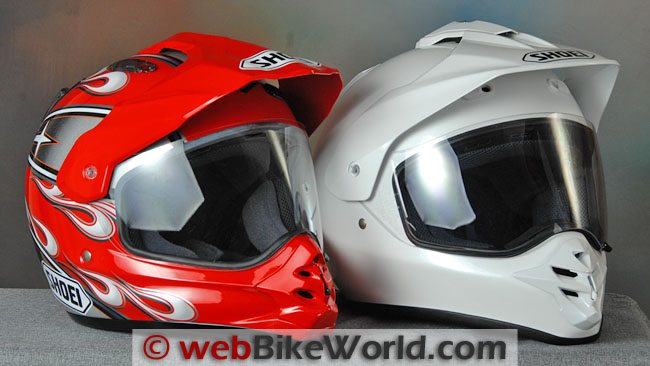
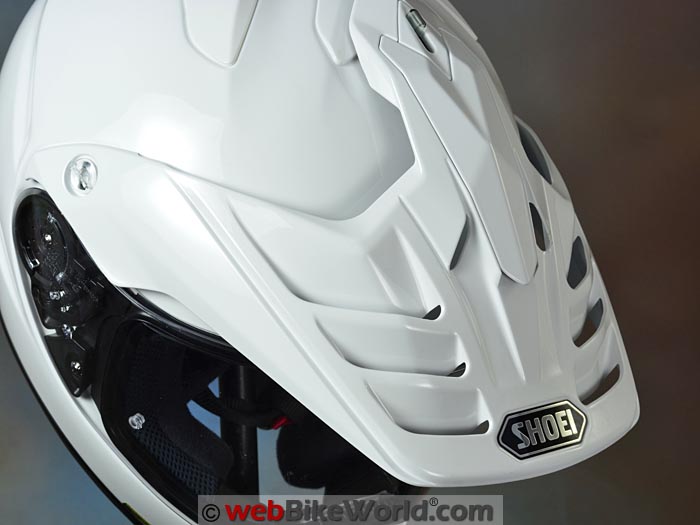
Miscellaneous
The Hornet X2 has a double D-ring chin strap attachment system with a snap to secure the loose end. The chin strap padding is very good.
The helmet has a recess that helps to hold a goggle strap along the back. We tried fitting a pair of goggles in the Hornet X2 with the face shield removed and it works fine.
Fitting eyeglasses is very subjective, due to the difference in head shapes and the match to the internal shape of the helmet. Also, eyeglass types and shapes are highly variable. More on this in the Owner Comments section below.
The peak is long enough to block some of the overhead sun, but it does not have a black appliqué or coating on the underside.
Also, the helmet design allows easy fitment of clamp-type or stick-on intercoms. The ear pockets have a recess in the EPS for smaller speakers.
- Excellent new design.
- Outstanding ventilation.
- Superior visibility.
- No face shield distortion.
- Independent face shield removal.
- Low noise levels.
- Snell 2015 and 5 year warranty.
- Weight.
- Price.
Conclusion
The Shoei Hornet X2 raises the bar in Dual Sport helmet design.
It is a complete re-think of the DS helmet type and it busts out of the typical “me too” Dual Sport helmet design mentality.
It works extremely well on the street — where this type of helmet will see most of its use — but it also does the job off-road. If you need more, go with a Shoei VFX-W motocross helmet.
If you’re an owner of one of the current crop of big Dual Sport/Adventure Touring bikes, you need to take a look at the Hornet X2.
Bottom line? The Hornet X2 is the gold standard to which all other DS helmets will aspire.
Where to Buy Shoei Hornet X2 Helmet
Check Reviews & Prices on Amazon Check Reviews & Prices On RevZillaSee More Motorcycle Helmets, Motorcycle Visor, Motorcycle Intercom
Owner Comments and Feedback
See details on submitting comments.
From “H.S.” (July 2015): “Thanks so much for the informative review. I do wonder if anyone else is having a hard time removing the helmet, though?
Not that I cannot stand removing it from my head because it’s sooo wonderful (but it’s close!).
When it’s on, it’s great – extremely comfortable…but I dread taking it off because the neck roll all but removes my ears from my head.
I’ve tried straight up, rolling it forward, rolling it back, thumbs pinching the neck roll below my ear lobes…nothing works and after three or four tries my poor ear lobes are crying “Uncle” and I shelve the helmet, grab something else!
I’m 54 years old, been riding since I was about 7 and have always worn a size Medium helmet, usually Arai but a couple of Shoei’s along the way.
I’ve sampled small and larges over the years just to double check that my noggin wasn’t expanding (or worse…contracting), but nope…medium.
Just curious if your testers noticed anything like this? Love your site! Lots of good gear decisions began and ended here…carry on!”
Editor’s Reply: Have not noticed this problem, perhaps someone else has?
From “H.S.” (June 2015): “As you will read below, the Hornet and I are not a harmonious pairing. Thought other readers might learn from my observations.
After reading your review, and trying one on (too briefly, I now realize), I purchased a size XL Shoei Hornet X2. It has many great features, some not so great, and a couple which make it un-wearable for me.
Despite my brief try-on, the Hornet X2 is rounder than my head, such that it causes me the mother of headaches on extended wear. I doubt if a bigger size would be better, as the basic shape would still be wrong for me.
For context, I bought this to replace a Shoei X-11 (review) in size XL (my all-time favorite helmet; I’ve owned three) and an Arai Profile (review) in XXL, both of which have been a great fit, but just “timed out.”
Hornet good points:
I like the peak; it really shades your eyes, making sunglasses less crucial. The huge eye port gives a great view, particularly peripheral, as when making head checks. Eyeglass fit is great for me, a big selling point. Simple vent controls are good.
The roomy chin bar / mouth area is good for hydration pack mouthpieces, yet gives plenty of clearance for use with a Leatt STX neck brace.
Now the not-so-goods:
This thing is a boat anchor! You will be shocked the first time you pick it up. I wouldn’t agree that the weight “goes away” when you put it on; weight is weight.
At any highway speed, turning your head from side to side gives your neck a real workout.
I guess that’s the peak catching the wind, but the excessive weight can’t help. I wouldn’t say the peak causes any “lift” at speed, however.
The vent controls are simple, but unfortunately they don’t seem to do anything! I can’t perceive any but the tiniest amount of air movement through the top or forehead vents.
The only way to get any cooling air into this thing is by opening the face shield all the way up, which isn’t useful at highway speeds.
I think this is regarded as a quiet helmet, but here again I can’t agree, at least with my application. Regardless of the windshield position on my BMW R1200GS Adventure (2011), the helmet causes a very irritating low-frequency rumble, that earplugs do little or nothing to mitigate.
In size XL (the largest shell size), the helmet will just barely fit in a standard BMW Adventure aluminum top box.
A final turn-off for me is that the D-rings, when snugged up, impinge painfully on my left jawline.
Since I make it a point not to keep torture devices, this will soon be on eBay. If you have the right head shape, you may well love it.”
From “P.L.” (May 2015): “Personally, for street use, I think any helmet should be outfitted with an internal sun visor. Unless you never face changing weather conditions or ride through tunnels. Or always ride North…”
Editor’s Reply: The problem with an internal sun visor is that the system requires space in the forehead, which reduces protection in that area. This is why you don’t see any Snell certified helmets with sun visor (that I’m aware of). Also, the sun visor usually adds weight (and complexity).
Better options in my opinion are the “el Cheapo” Sun Shade (review)” or the Sunax Sunshield (review).
From “D.M.” (May 2015): “Could you comment further on your testers’ experience with eyeglass fit? That is a deal-breaker for me with the Shoei GT-Air (review), and I wonder if the Hornet X2 is any more eyeglass friendly.
Second, I find it interesting that the face shield CAN be removed and replaced without removing the peak. The owner’s manual states clearly that the peak should be removed before the face shield is removed. Is that Shoei just being super-cautious?”
Editor’s Reply: Like just about everything else on a helmet, eyeglasses fit is highly subjective and will depend on the wearer’s head shape and eyeglass type.
I wear a pair of the Randolph Engineering Aviator sunglasses we reviewed, they have straight thin temples, designed to fit in a helmet. They work fine in the Hornet X2.
My head is widest at the temples, so I actually don’t correctly fit in a Shoei helmet with the Shoei narrower internal shape, yet the glasses work fine.
Again, this will really depend on the individual. As we stated in the review, Shoei has probably the most consistent internal shape standard of any helmet manufacturer, so if a GT-Air isn’t working for you (it doesn’t for me either), then the Hornet X2 may not either.
Regarding the peak, the face shield does come off without removing the peak. It’s a little tight, and of course due to the peak, it doesn’t pop right off like it would on a full-face Shoei street helmet, but it works.

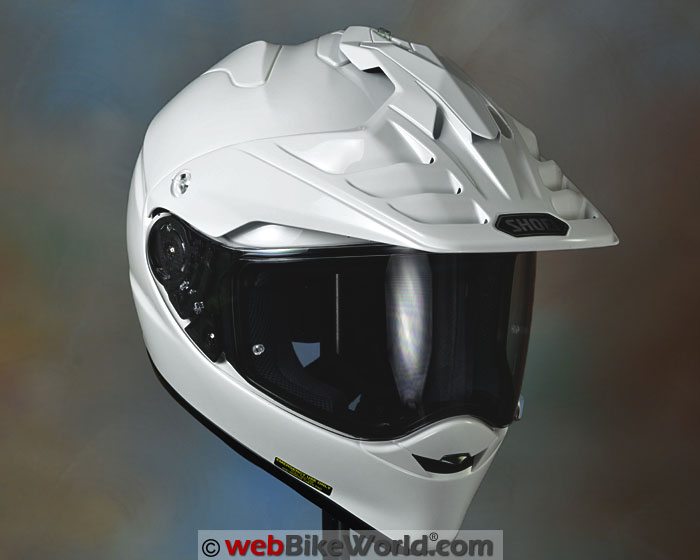
 Introducing the Shoei Hornet X2
Introducing the Shoei Hornet X2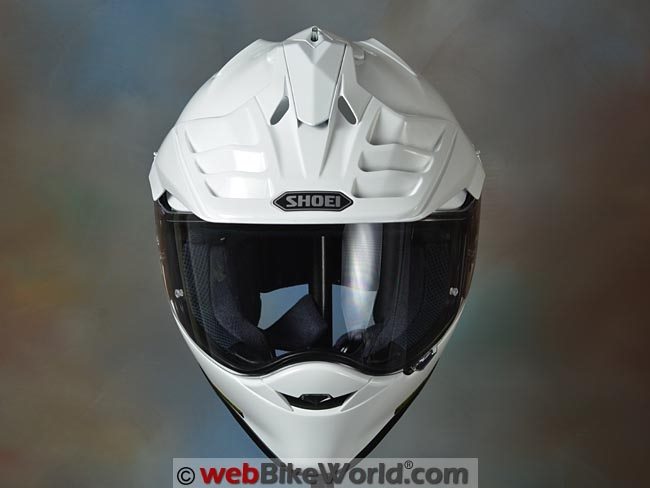
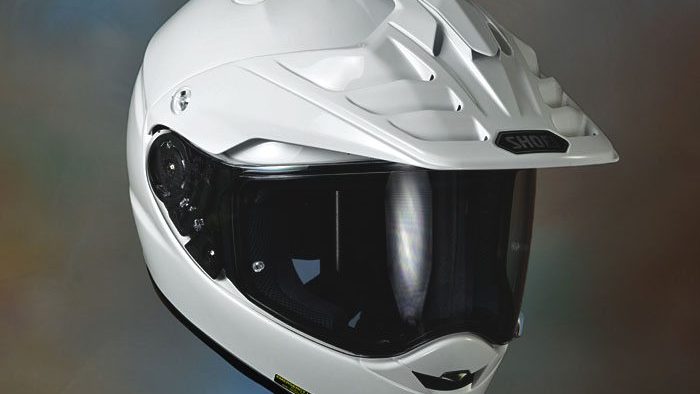
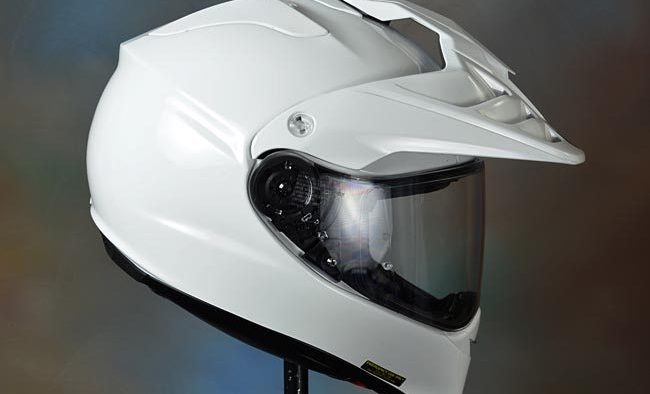

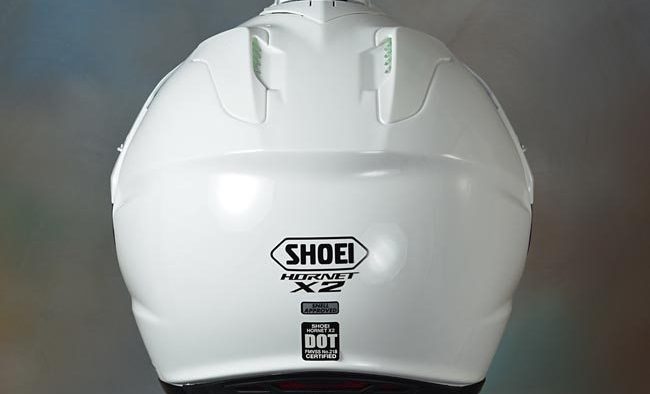
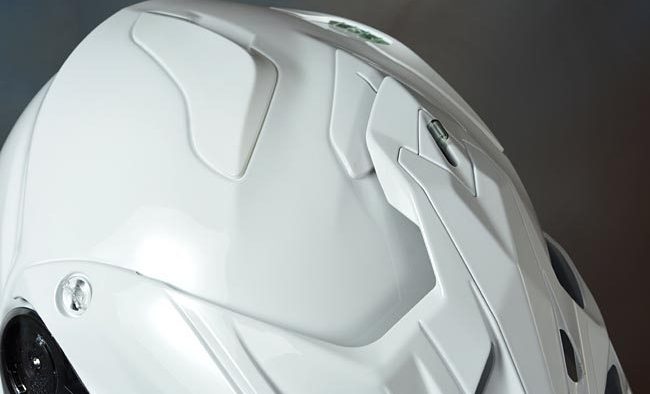
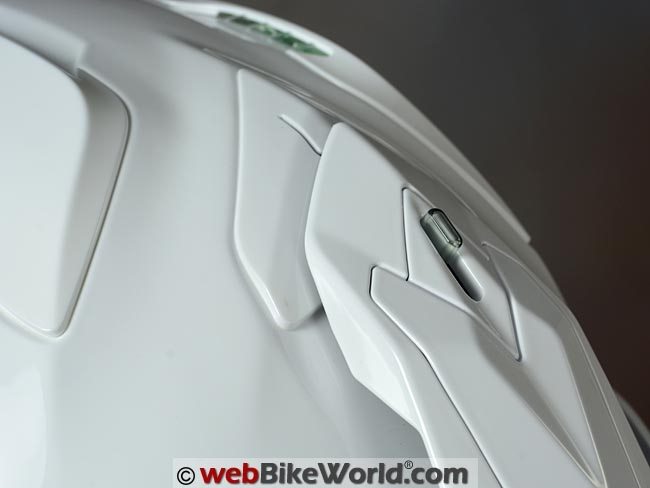
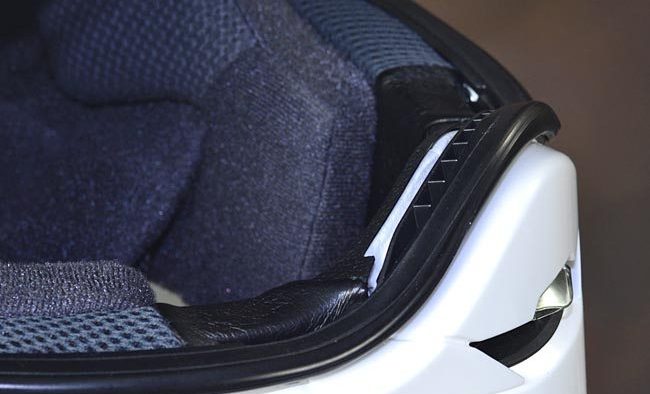
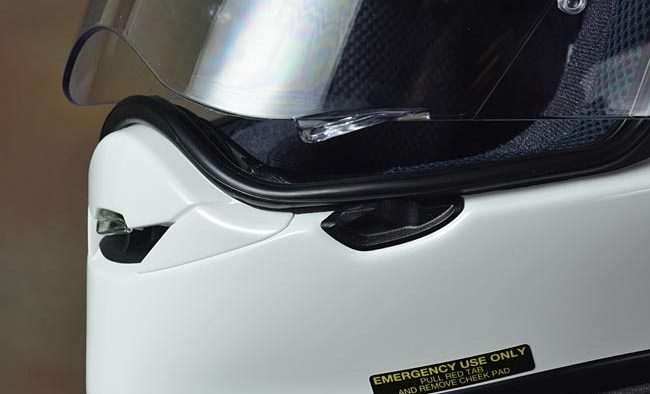

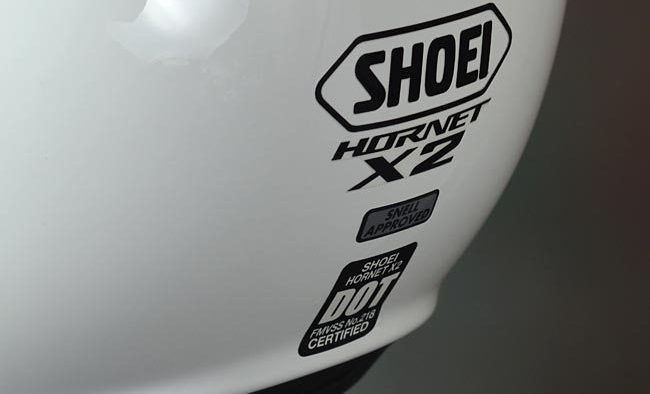
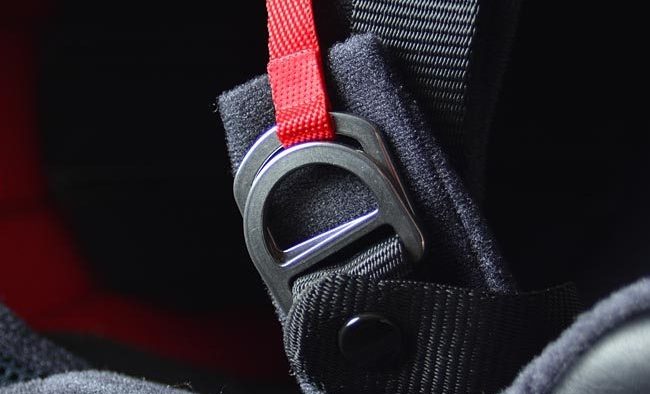
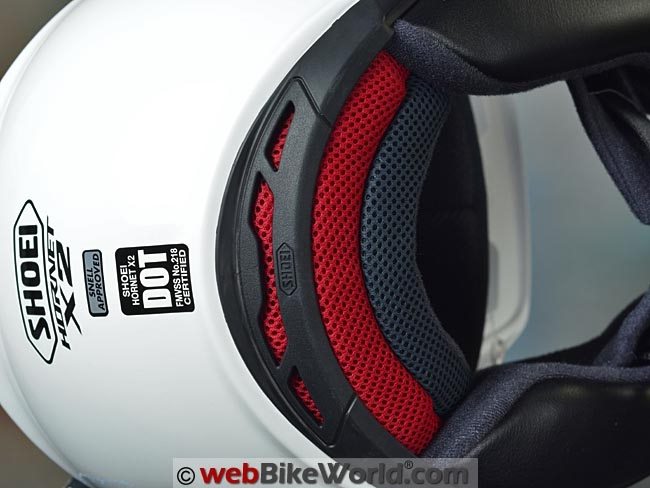


No Comment